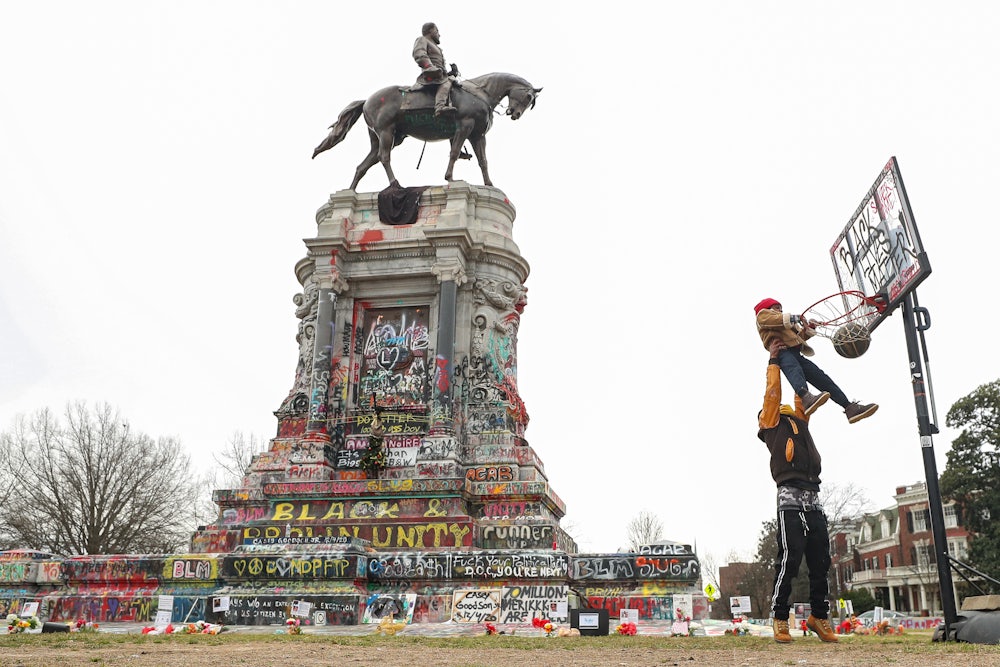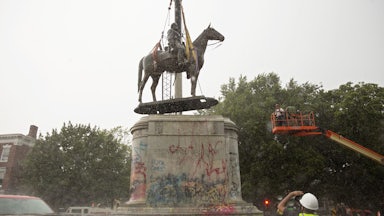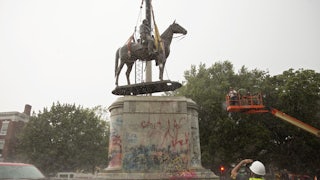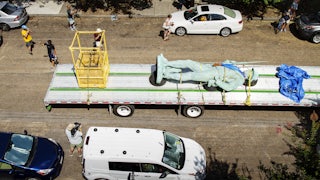Last Thursday, the Virginia Supreme Court ruled that a statue honoring one of the greatest traitors the United States has ever produced can, at long last, come down. The state of Virginia may now begin to disassemble the behemoth sculpture honoring Confederate Gen. Robert E. Lee that resides on the city’s fabled Monument Avenue, on which statuary to Confederate luminaries (and much later, after considerable discord, homegrown Black tennis superstar Arthur Ashe) has long stood. While the timeline for the ultimate removal is yet to be determined, as Governor Ralph Northam said upon the announcement of the court’s ruling: “Today it is clear—the largest Confederate monument in the South is coming down.”
The impending removal of Lee’s statue is hardly a panacea for ongoing racial strife in the U.S., not least after the past few years of a president who fractured race relations in unprecedented ways. It is, however, a chance to dismantle the hagiography surrounding a man who commanded troops to slaughter tens of thousands of American soldiers, all in pursuit of shattering the U.S. while expanding the enslavement of millions of Americans. It is a chance finally to place Lee among the pantheon of our nation’s most malignant enemies.
The Richmond statue to Lee—clocking in at six stories high and some 12 tons in weight—isn’t simply the most prominent piece of Confederate remembrance still standing in the U.S. When it was initially erected in 1890, in front of over a hundred thousand onlookers, it represented a clear turn in the burgeoning growth of Lost Cause mythologizing. As historian David Blight writes in Race and Reunion, “More than ghosts emerged from the Richmond unveiling of 1890; a new, more dynamic Lost Cause was thrown into bold relief as well.”
With the unveiling of Lee’s statue, mewling protests about Northern aggression had given way to muscular Confederate memorialization—with national reconciliation, added Blight, now “dependent upon the dead leader of the cause that lost.” Gone were the days of faction and friction among white Americans, replaced by a white supremacist comity and Jim Crow regime built under the shadow of Lee’s new statue—a state of affairs that would last decades, entrenching an American apartheid of which Lee would have heartily approved.
It’s not as if Lee’s rank treason is any kind of secret. Lee may not have been as histrionic as some of the human enslavers leading state governments into the Confederacy, or as colorful as some of the other former American military officials who elected to lead the Confederacy’s white supremacist insurrection. In many ways, that distance remains part of Lee’s ongoing appeal. Bathed in alleged honor, clad in supposed chivalry, Lee, for decades, has stood as a man more sinned against than sinning—a supposed titan of gentlemanly warfare swept against his will into the tempest of his times; the avatar of a willingness to stand in defense of one’s principles, however blinkered (and treasonous) they may be. As W.E.B. Du Bois once wrote, “It is the punishment of the South that its Robert Lees … will always be tall, handsome and well-born. That their courage will be physical and not moral.”
Du Bois is precisely correct. Rather than joining the hundreds of thousands of white Americans across the South who remained loyal to the U.S. during the Confederacy’s short-lived fratricide, Lee elected to join a traitorous band of effete, elite white Southerners bent on imploding the U.S., carving out new slavery territories across the American West and expanding chattel slavery as far as they could.
The Confederacy, as American general (and future president) Ulysses S. Grant would later write, was “one of the worst [causes] for which a people ever fought, and one for which there was the least excuse.” It was a movement that sought, as historian Stephanie McCurry wrote, to build “something entirely new in the history of nations: a modern proslavery and anti-democratic state, dedicated to the proposition that all men were not created equal.” It was one that was willing to decimate and destroy as many loyal Americans as it needed to get there. And it was one that Lee joined with enthusiasm—all for, The New York Times noted, “the protection of slavery.”
Lee, like the Confederates he freely joined, viewed the maintenance of white supremacy as his central tenet and as the primary reason he spent years helping cause the deaths of innumerable American troops. Prior to the war, Lee had no problem bloodying the Black Americans he owned, nor in shattering the families he personally enslaved, with one historian noting that by 1860, Lee “had broken up every family but one on the estate.” During the war, Lee’s white supremacy turned darker yet, with his troops abducting and enslaving Black Americans and massacring Black American troops attempting to surrender.
He spent the latter years of his life stupendously failing to earn redemption. After the war, Lee hardly aided in the kind of racial reconciliation pursued by the Lincoln or Grant administrations. While bands of white supremacist terrorists ransacked Reconstruction-era governments, obliterating efforts to create a multiracial democracy, Lee sat on his hands. He joined a large swath of Confederate leaders after the war who, as historian Elizabeth Samet writes, did “little to further the postwar settlement. In many cases, they worked to undermine the government’s policies, especially with regard to African-Americans.” Added author Clint Smith, Lee “did not become open to the creation of a society based on racial equity; he actively opposed it. He argued, for example, that Black people should not have the right to vote.”
Disavowing his oath of loyalty to the U.S., leading a movement to carve up the nation while extinguishing the lives of hundreds of thousands of American soldiers, in the hopes that he and his compatriots could throw off their American citizenship and continue enslaving millions of Black Americans: Lee belongs firmly among the highest ranks of American quislings, mentioned in the same breath as those like Benedict Arnold. For all who can see him clearly, Lee’s treason shines brightly, a century and a half after he led insurrectionists bent on disintegrating this country.
Thousands of Confederate memorials remain scattered like a pox across this country, honoring the most anti-American movement the U.S. has yet seen. (Imagine if, say, London constructed hundreds of statues to George Washington, or Mexico created hundreds of monuments honoring Sam Houston.) It wasn’t until 2021 that an American president finally and accurately described the Confederate flag as a “symbol of hate.” But the removal of the statue in Richmond is both a capstone to the anti-Confederacy movement that’s begun rippling across the country in recent years and a sign of a tide finally, decades after it should have, beginning to turn.
Not all Americans are there yet, of course; some still refuse to see Lee for the rank traitor he was, claiming such framing is a fleeting fad of the times. They couldn’t be more wrong. “There are but two parties now, Traitors and Patriots and I want hereafter to be ranked with the latter,” Grant wrote about the movement Lee led. Immediately after the war, a federal grand jury specifically indicted Lee for treason—he only avoided charges when Grant interceded, claiming such charges would abrogate the surrender agreement at Appomattox. The only reason Lee never faced treason charges he rightfully feared was thanks to the man who’d bested him on the battlefield—the man who remained loyal to his country and who put paid to the idea that Lee, as his supporters still believe, was some kind of military genius.
Such a move kept Lee from the gallows, and from American ignominy, for far longer than he deserved. But with the bulldozing of Lee’s statue in Richmond, we can finally dismantle the myth cloaking one of the greatest enemies the U.S. has ever seen—and finally see Lee as the traitor he’s always been.








